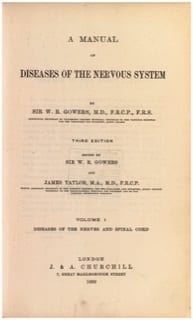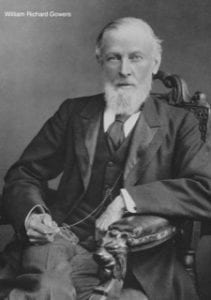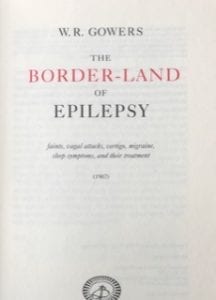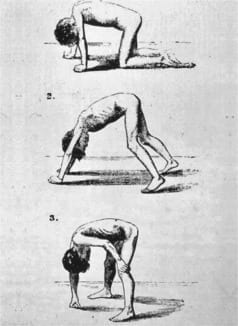JMS Pearce
Hull, England
 |
| Fig. 1 Gowers’ Manual. A Manual of Diseases of the Nervous System. J London: J. & A. Churchill 1886 |
The name Gowers is a name hallowed in the minds of most neurologists as one of the great founders of neurological medicine in the Victorian era. He is probably best remembered for his A Manual of Diseases of the Nervous System (1886) (Fig 1.), a rich source of wisdom and clinical description that can still instructs us in its lucid, reasoned understanding. It remains the unsurpassed single-author “bible” of neurology.
A brief account can scarcely do justice to the lasting legacy of Gowers. In a career so productive and influential it is impossible to escape encomium, avoid hagiography, or to omit mention of his numerous publications. Two outstanding books are devoted to the details of Gowers’ life and extensive bibliography. The erudite Macdonald Critchley wrote the first in 1949.1 The second and most recent is a scholarly text, written by his great-granddaughter Ann Scott, and the distinguished neurologist-historians Mervyn Eadie, and Andrew Lees, which includes previously unrecorded family sources, letters, and memorabilia.2 It brings to light new archives (42 volumes and 2,478 patients) of Gowers’ case notes at Queen Square from 1878 until his retirement in 1911.
William Richard Gowers (1845-1915)
Of modest origins, Gowers (Fig 2.) was born on 20 March 1845 in Hackney, son of a shoemaker, William Gowers and Ann Venables. He attended the Hackney Free and Parochial School. His father died when he was only eleven and his mother took him to her family home in Headington, Oxford, where he studied at Christ Church College School until he was fifteen. With few friends, his natural, self-driven industry and curiosity helped him to acquire a mastery of language, shorthand, drawing, painting, and natural history.
On leaving school, uncertain of his future, he worked as a farmer’s boy in Bentley, Yorkshire, but soon moved to stay with family at West Street, Coggeshall in Essex, where Dr. Thomas Simpson took him on as an apprentice. His duties were to dispense medicines and drive the pony and four-wheel gig, whilst at the same time continuing his private studies. He taught himself shorthand, and wrote an 80,000 word diary of his activities from the time of this apprenticeship until his most productive years 1870-1890. He passed the London Matriculation in 1863 and a few months later he left Coggeshall to live in lodgings with his mother in Roxburgh Grove, London. His industry was rewarded when he obtained a place at University College Hospital (UCH) as a medical student.
 |
| Fig. 2 William Richard Gowers |
We can guess he was an outstanding student, for on qualifying MRCS in 1867 he was chosen to work at UCH as assistant and amanuensis to Sir William Jenner, Court doctor and President of the Royal College of Physicians, of whom he later wrote: “The daily intercourse with that intellect was a privilege inestimable.” At University College he was motivated by Russell Reynolds, an early appointee at the National Hospital for the Paralysed and Epileptic, who fostered his interest in neurology.
He passed the M.B. London with first class honors in 1869 after he had already secured the Gold Medals for Botany, Physiology, Anatomy, and Materia Medica. He then graduated M.D, with Gold Medal, and in 1870 was appointed Medical Registrar to the National Hospital for the Paralysed and Epileptic at 24 Queen Square, founded ten years earlier. He worked for the founding consultants Jabez Ramskill and C. E. Brown-Séquard, and for Hughlings Jackson, G B. Radcliffe, Russell Reynolds, E. H. Sieveking, Thomas Buzzard, and Charlton Bastian. He created an inventory of all the inpatient diagnoses and appraised the treatment outcomes of 500 patients in the year 1870, a task that impressed his senior colleagues.
It was soon evident that he was an astute clinician and consummate observer and recorder. His efforts were fulfilled when he was appointed two years later as Honorary Assistant Physician to the National Hospital and to UCH. He was elected Fellow of the Royal College of Physicians in 1879.
In 1875 he married Mary Baines, the daughter of Frederick Baines of Leeds, the editor of the Leeds Mercury; they had two sons and two daughters. They lived at 50 Queen Anne Street, London until his retirement.
Despite a heavy clinical workload he published a number of early clinical papers and authoritative books, expounded by Critchley.1 In 1877 appeared papers on the arteries in Bright’s disease, the diagnosis and treatment of auditory vertigo, visceral syphilis, and the pathology of chorea.
Like Thomas Clifford Allbutt and Hughlings Jackson, Gowers became an early advocate of the use of the ophthalmoscope, realizing its value in diagnosis, as shown in his Manual and Atlas of Medical Ophthalmoscopy, superbly illustrated with his own drawings.
 |
| Fig. 3 The Borderlands of Epilepsy. London: J. & A. Churchill 1907 |
He edited the section on the central nervous system for Quain’s Anatomy in 1876, and wrote articles on the blood in Reynolds’s System of Medicine in 1877 & 1879. He invented the hemocytometer to measure red blood cells and later the Gowers’ hemoglobinometer.
Many articles followed, dealing with and importantly adding to understanding of epilepsy, chorea, and descriptions of many neurological disorders including: migraine, myasthenia gravis, neurosyphilis, lumbago, muscle diseases, and paralysis agitans.3 Such a record has never been equalled in neurology.1 He introduced the terms knee jerk, fibrositis, and abiotrophy—the concept of neural degeneration in consequence of a defect of vital nutrition and endurance—perhaps anticipating apoptosis. He played a major diagnostic role in the beginnings of neurosurgery with his celebrated colleague Victor Horsley.
Stimulated by Hughlings Jackson, Gowers in 1880 gave the Goulstonian lecture on epilepsy, based on a series of 1,450 personally observed cases. The second edition of Epilepsy and Other Chronic Convulsive Disorders in 1901 disclosed his huge experience of 3000 cases of epilepsy and unmatched insights into its diverse symptomatology, later amplified in Borderlands of Epilepsy 1907. (Fig 3.)
In 1879 he published his monograph on pseudohypertrophic muscular paralysis (Duchenne muscular dystrophy), adding his own experience of twenty cases to Meryon and Duchenne’s accounts.5 He graphically related how children so afflicted scrambled up from the ground, still known as “Gowers’ sign” (Fig 4.):
He therefore places his hands on his knees, . . . his arms thus bring much of the weight of the upper part of the trunk on the femur close to the fulcrum, between this and the power, which can then act at greater advantage. . . . When the knees are extended, the power of the extensors of the hip may be sufficient to raise the body into the upright position, . . . the hands are often moved higher and higher up the thighs, grasping alternately, and thus pushing up the trunk, sufficient to enable the extensors of the hip to bring the trunk into the upright position. [“climbing up their own legs”]
His paper “Some Symptoms of Organic Brain Disease” was published in the first issue of the journal Brain in April 1878. Critchley observed:
The year 1879 proved a sort of annus mirabilis for Gowers with four important works either written or published in addition to these shorter papers. First we have the lectures on Epilepsy; next a monograph on Pseudohypertrophic Paralysis; thirdly, his address on the Diagnosis of Diseases of the Spinal Cord, and fourthly, his Manual of Medical Ophthalmoscopy. Four masterpieces thus saw the light, each of which was the product of detailed and careful research, and all of them broke new ground. 1
 |
| Fig. 4 Gowers’ sign in Duchenne dystrophy |
Gowers used his skill at shorthand to keep detailed clinical notes, which informed his magnum opus A Manual of Diseases of the Nervous System (1886-1888), skillfully illustrated with his own drawings. Critchley advised that anyone who thinks he has stumbled upon something new or obscure should not neglect to search the Manual before claiming originality. His friend Sir William Osler reviewed it, stating: “As a text book on the subject [it] stands unrivalled in any language . . . the author, at a comparatively early age, [is] among the highest living authorities on all matters relating to diseases of the nervous system.”5 In 1887 he was elected Fellow of the Royal Society, and was knighted in 1897 in Queen Victoria’s Diamond Jubilee honors. Sir William Osler would later describe him as “the ornament of British medicine.”
Gowers’ methods
We should remember that until Gowers’ time, medicine and neurology were essentially uncharted territories awaiting a period of rapid advance in medical knowledge. His bedside skills probably had their roots in his meticulous observations of plants and animals examined in childhood. These methods were those of a scientific observer and obsessional recorder of natural morbid phenomena. He summed up:
“If a man habitually observes more fully, more precisely and more carefully he becomes a better observer, able to perceive more accurately, more minutely more adequately to obtain precision…We might take as our motto the words: ‘writing maketh an exact man.’” 6
Gowers did not indulge in philosophical abstraction, nor rely much on animal experiments, but used his own detailed clinico-pathological experience. In selecting suitable cases for investigation he advised:
“In general it is a mistake to publish single cases. Far better to work up single points or publish a special case after working up its points comparatively. Nothing pays except that which gives some new suggestion. The great thing is to create a feeling in the reader — I must note anything else, this man says. . . .”
He had an admirable literary style: simple, arresting and clear. He took pains as well as pride in his lectures and writing. His lucid lectures were overcrowded with students, and visitors from abroad. His manuscripts show numerous erasures and corrections in the search for the best means of expression. He would have been proud of his family, notably the literary accomplishments of his son Sir Ernest Gowers (1880–1966), famously the author of Plain Words (1948), a corrective for bureaucratic English usage.*
Legacy
He often acknowledged the inspirational example of Hughlings Jackson. Whereas Jackson’s contributions were clinical, seeking the underlying physiology, Gowers’ meticulous observation of clinical phenomena aimed at uncovering the diagnosis and basic pathology of disease processes. The two were largely responsible for the development of the National Hospital as the foremost neurological institution.
There are many ways of appraising a man’s professional worth; firstly, is his reflection in those he trained. In this category Gowers could boast: James Taylor, Risien Russell, James Collier, Edwin Bramwell, Farquhar Buzzard, Holmes, Barnes, Wilfred Harris, Kinnier Wilson, all of whom had been his pupils or assistants. Secondly, is the quality of his published work.
Thirdly, original descriptions may further his reputation. Gowers scorned the use of eponyms; but ironically several survive that reflect his name. The best known of these are: Gowers’ phenomenon, Gowers’ distal myopathy, Gowers’ solution in the treatment of migraine, and Gowers’ anterior spinocerebellar tract. There are three eponymous signs: pain along a compressed sciatic nerve when the foot is dorsiflexed (Gowers’ phenomenon); the irregular contraction of the pupil in early tabes dorsalis (cf. Argyll Robertson pupil); and the climbing up the legs (Gowers’ sign) in Duchenne dystrophy.
Gowers was a competent pathologist, a bold, original thinker, and well-read in classical and foreign literature. He was both admired and feared by his contemporaries. Gordon Holmes told Charles Symonds that “Gowers was authoritative and sarcastic, and would publicly reprove his residents when he found cause for disagreeing with their observations. . . . They were afraid of him.” His raucous voice swiftly denounced careless work. But Critchley thought this was a facade which concealed a sensitive kindliness towards those who understood him. Although preoccupied by his work he was devoted to his family and accompanied his children in a wide range of recreational interests, not least his lifelong fascination with mosses. Some of his sketches were exhibited at the Royal Academy.
Later years
Gowers was plagued by sciatica and lumbago for many years. His health declined with a progressive gait disorder forcing retirement in c.1910. In 1911 he wrote, “I am suffering from paraplegia from lateral sclerosis . . .” And in March 1913 his friend Osler wrote to Silas Weir Mitchell: “You will be sorry to hear that Gowers is very ill—his own disease, ataxic paraplegia, it looks like, and ascending, so that now there are bulbar symptoms.” 7 This Critchley disputed, noting that “at the age of sixty-two [Gowers] became so feeble from generalised cerebrovascular degeneration as to determine his retirement.”8 He died peacefully on 4 May 1915; death was certified as due to coma resulting from arteriosclerosis. He was cremated at Golders Green Crematorium and buried with his wife and several of the Baines family in the Lawnswood Cemetery in Leeds.9 John Hughlings Jackson and William Richard Gowers are inextricably linked to Yorkshire; one by birth (Jackson), the other in death (Gowers).10
* His direct decendants include: Sir Ernest Arthur Gowers (1880-1966) Civil Servant, author of Plain Words, 1948), And Revision Of Fowler’s Modern English Usage. William Richard Gowers (1910-1985 ) CBE, Solicitor & Mayor of Oxford. William Patrick Gowers (1936 –2014) Musician, & Composer. Sir William Timothy Gowers, FRS (1963-) Professor of Pure Mathematics and Mathematical Statistics University of Cambridge.
|
SELECTED BOOKS |
| Pseudohypertrophic Muscular Paralysis. London: J. & A. Churchill 1879 |
| Diagnosis of Diseases of the Spinal Cord. London: J. & A. Churchill 1879 |
| A Manual And Atlas of Medical Ophthalmoscopy. London: J. & A. Churchill 1879 |
| A Study of the So-Called Tendon-Reflex Phenomena. Med.-Chir. Trans. 62. Published By the Medical And Chirurgical Society. London: J.E. Adlard, 1879 |
| Epilepsy And Other Chronic Convulsive Diseases: their Causes, Symptoms & Treatment. London: J. & A. Churchill 1881 |
| Lectures On the Diagnosis of Diseases of the Brain. London: J. & A. Churchill 1885 |
| Diagnosis of Diseases of the Brain And of the Spinal Cord. New York: William Wood, 1885. |
| A Manual of Diseases of the Nervous System. J London: J. & A. Churchill 1886 |
| Lectures On the Diagnosis of Diseases of the Brain. Delivered At University College Hospital. London: J. & A. Churchill, 1887 |
| Syphilis and the Nervous System. London: J. & A. Churchill 1892 |
| The dynamics of life. London: J. & A. Churchill 1894 |
| Lectures On Diseases of the Nervous System. Second Series London: J. & A. Churchill 1904 |
| The Borderlands of Epilepsy. London: J. & A. Churchill 1907 |
References
- Critchley M. Sir William Gowers, A Biographical Appreciation. London, Heinemann 1949.
- Scott A, Eadie M, and Lees A. William Richard Gowers 1845-1915. Exploring the Victorian Brain. Oxford, OUP, 2012
- K. L. Tyler William Richard Gowers (1845–1915). J Neurol 2003; 250:1012–1013
- Pearce JMS. Gowers’ sign. J Neurol Neurosurg Psychiatry. 2000; 68(2): 149.
- Boes CJ. Gowers and Osler: good friends ‘all through’. J R Coll Physicians Edinb 2016; 46: 55–64
- Shorvon S, Compston A. Queen Square: A History of the National Hospital and its Institute of Neurology. Cambridge University Press, 2019:pp. 145-154
- Cushing H. The Life of Sir William Osler. 2 volumes. Oxford: Clarendon Press; 1925. Cited by Boes5
- Critchley M. The Black Hole and Other Essays. London: Pitman Medical Publishing Co, 1964.
- Boes CJ, Toodayan N, Lees A. Finding the grave of Sir William Richard Gowers. Practical Neurology 2017;17:321-322.
- Pearce JM, Lees AJ. Yorkshire’s influence on the foundation of British Neurology. J Neurol Neurosurg Psychiatry 2013;84:6-9.
JMS PEARCE is a retired neurologist and author with a particular interest in the history of science and medicine.

Leave a Reply